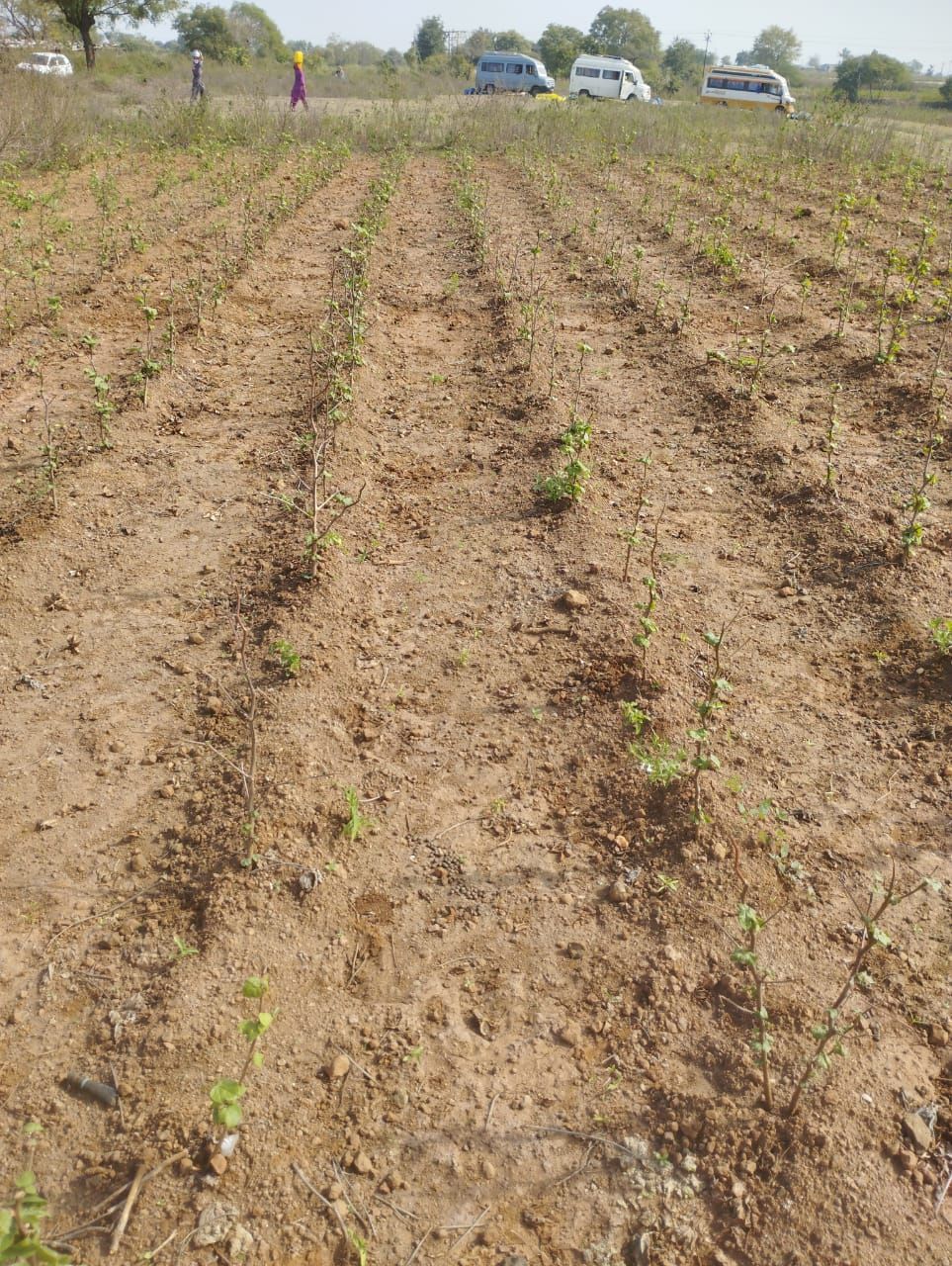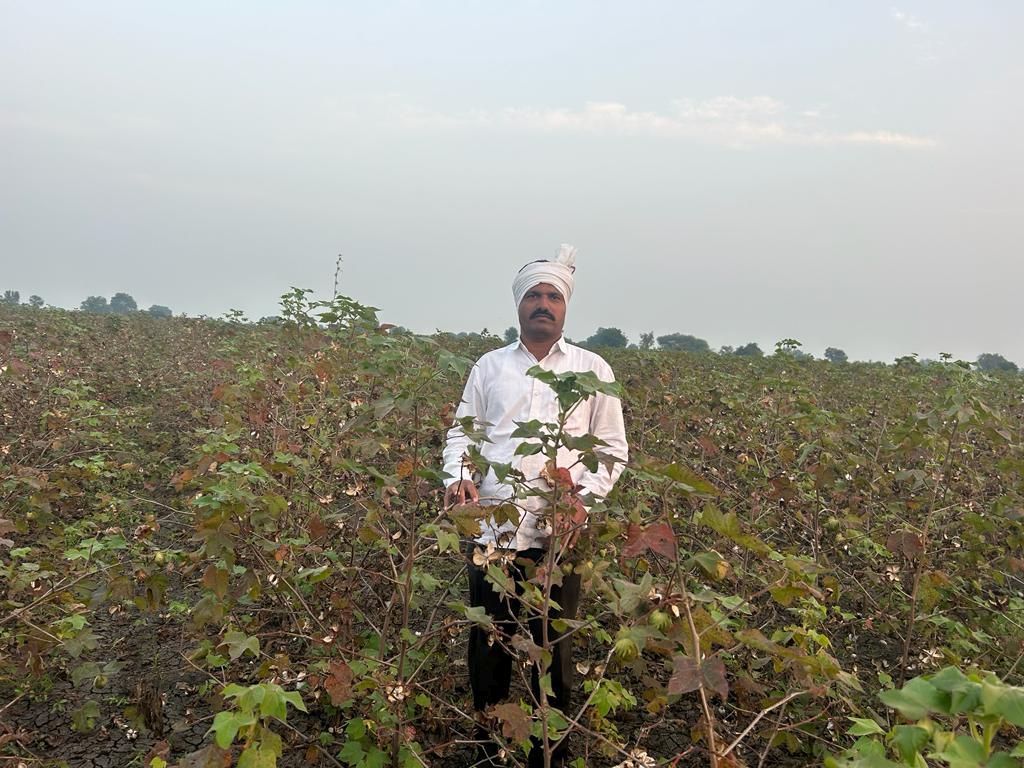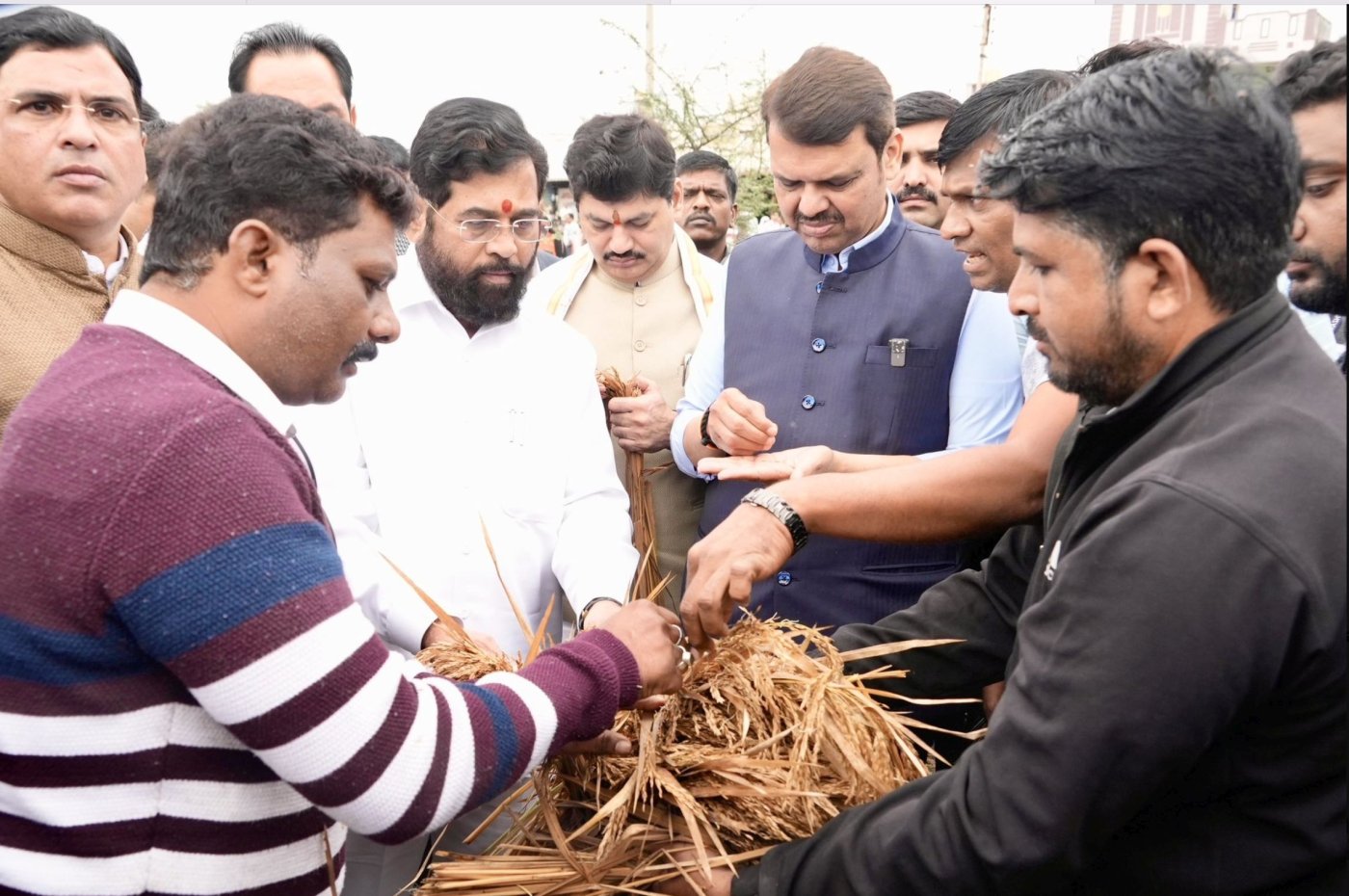Mumbai: When a union government-appointed team visited parts of Maharashtra to take stock of deepening rural distress from agricultural drought in the second week of December 2023, Ravindra Kisan Bawaskar, 52, was among those who gathered to direct the visitors around the expansive farmlands of Fardapur, a large village of more than 10,000 people in Chhatrapati Sambhajinagar district, formerly called Aurangabad, 425 km east of Mumbai.
“We showed them acres and acres of cotton fields, lying unattended since September,” said Bawaskar, who owns nearly 7 acres, more than the average for the village.
The fields looked green, but no farmer had managed to scrape together even 30% of their usual cotton yield, Bawaskar said, with the monsoon playing truant during a critical period for boll formation.
Lack of rainfall during the flowering and boll formation period usually spells bad news for a cotton crop. Flowers and bolls drop off or bolls don’t develop as they should, which ultimately leads to low yields of fibre.
“We had almost no boll formation at all,” said Bawaskar, “because it simply did not rain in August.”
Several village clusters in the vicinity received between 15% and 45% of the monthly average rainfall in August 2023.
Fardapur’s villagers cultivate over 2,000 hectares of land, most of it cotton. They were reeling under losses and unpaid loans with 80% of the cotton crop devastated, said Shakilabi Shaikh Hussain, the sarpanch or elected head of Fardapur.
“Soyabean and corn farmers were also affected, but the cotton farms took the brunt of this drought,” said Hussain.
Notwithstanding early confirmation in the summer of 2023 that it would be an ‘El Niño’ year, with the possibility of increased temperatures in the central and eastern Pacific Oceans bringing lower rainfalls and greater likelihood of droughts, crop losses and heatwaves, overall rainfall in Maharashtra during the southwest monsoon period from 1 June to 30 September was 89.4% of the long period average (LPA) forecast.
The month of August, however, saw seven meteorological subdivisions in the north-west of the country record deficient rainfall. Fifteen subdivisions received “large deficient” rainfall (-99% to -60% of LPA). The “most noticeable feature” of rainfall distribution was the deficiency in August across most of India, said the Met department’s end-of-season report, “especially over the western part of the country”.
The result is pockets of acute agrarian distress in parts of Maharashtra, as another drought year shrinks farm incomes despite a string of lofty promises—doubling farmers’ incomes by 2022, a ‘drought-free’ Maharashtra, and a Rs 20,000-crore water grid linking rivers statewide.
Farm distress in Maharashtra does not stem from the climate crisis alone.
A December 2022 audit report by the Comptroller & Auditor General of India (CAG) on six surface irrigation projects revealed delays, cost overruns and considerable shortfall in irrigation of targeted land.
The gap between the actual creation of irrigation potential and projections ranged from 3.20% to 43.56%; and utilisation of the irrigation potential created ranged from zero% to 85.94%. This was for the 2014-15 to 2020-2021 period.
Drought & Distress
Maharashtra has recorded a series of acute droughts in recent years. At the peak of the summer in 2019, water reserves plummeted to 19%; by October 2018, the government had already declared over 180 talukas out of a total of 353 or over half the state as drought-affected, with more than 11,000 villages affected; in 2014, the government declared 24,000-odd villages as being drought-hit, including every single one of the Marathwada region’s 8,139 villages.
Though there is no official word on hydrological drought marked by acute water scarcity and severe depletion of surface and groundwater levels, another season of agricultural drought hit the kharif (fed by the southwest monsoon) cropping season, with its concomitant struggles for the rural poor in the affected regions—the inability to find livelihood in their native villages; a dip in sowing of rabi crops as water and capital are both depleted; and a slow collapse of the village order triggered by distress migration, growing dependence on the State’s relief measures and ex-gratia payouts for crop loss; and a silent mental health crisis.
On 31 October 2023, the state government announced that 40 talukas in 15 districts spread across Maharashtra had been found to be suffering from agricultural drought, based on assessments of rainfall received in the June-September period, groundwater levels, the condition of the kharif crop, total sown area, etc. The government said villages in 24 talukas were reeling under “serious” drought while 16 talukas faced “medium” levels of distress.
Ten days later, the government declared “drought-like” conditions in 1,021 revenue circles or village clusters, located in 178 talukas.
The 40 talukas announced on 31 October and the 1,021 clusters announced later will all be eligible for a slew of government measures designed to mitigate immediate socio-economic effects of drought: waiver of land revenue bills, restructuring of crop loans, a temporary suspension of crop loan recovery, a 33.5% discount in energy bills for agricultural pumps, a waiver of exam fees for college and school students and widening of the scope of work made available through employment guarantee programmes.
Those measures are only as per the drought manual, said Ajit Nawale, the farm leader of the All India Kisan Sabha who led the historical farmers’ strike of 2017, who has called for a slew of relief measures and rates of crop loss compensation to be updated to match current prices of farm inputs.
“We were shown a dream of farmers’ incomes being doubled by 2022, but we lack even measures for real relief during distress,” he said. Maharashtra has the highest cost of production for most crops, he said, calling this a key reason for the continuing farmer suicides in the state, the most in the country. “Just talking about farm goods’ prices that will be 1.5 times the cost of cultivation and doubling of income is meaningless without reducing the cost of production,” he said.
Chief minister Eknath Shinde of the Shiv Sena told the state legislative assembly on 18 December that his government had drawn up plans worth Rs 44,000 crore for the agriculture sector and for empowering farmers.
“In the last one and a half years, there was drought, heavy rains, unseasonal rain, floods, hailstorms,” said Shinde. “In every calamity and crisis, our government has stood firmly behind farmers.”
There is almost no impact on the ground of the government’s mitigation measures, according to Nawale, Maharashtra general secretary of the All India Kisan Sabha, which is affiliated to the Communist Party of India (Marxist).
Crop loss compensation payments are lagging, while the restructuring of loans instead of a loan waiver is seen by farmers as “today’s death rescheduled for tomorrow”.
The winter session of the state legislature ended with neither the Opposition nor the government discussing farm distress at length, said Nawale. “Instead,” he said, “they focused on a caste issue that has people polarised and battling one another.”
The Search For Livelihood Begins
The region around Fardapur does not traditionally undertake a rabi or winter season crop (sown when temperatures dip), because the south-west monsoon brings the district an average of less than 540 mm of rain from June through September. Fewer than half of Marathwada’s villages produce a rabi crop, and those that do largely produce sorghum or millets, much of it for home consumption.
“People have no option but to go in search of work, mostly as labourers, in the touristy places near the Ajanta caves,” said Bawaskar.

Fardapur is located just 3.5 km north of the iconic rock-cut Buddhist cave temples dating back to the 2nd Century BC, also a UNESCO World Heritage Site that receives over 5,000 visitors daily in the October to January period.
“Some will wait for the next kharif season to take a loan, those who need cash will approach the sahukars (private money-lenders, notorious for usurious rates of interest) now,” said Bawaskar.
Many will travel to Chhatrapati Sambhajinagar city, formerly called Aurangabad, to find work, said Bawaskar. A few hundred families from Fardapur will work at brick kilns in nearby Beed district.
Many more will join the migration for sugarcane harvest, said Krishna Tidke, the Beed district president of a Bharatiya Janata Party(BJP)-led union of cane harvest workers, transporters and labour contractors.
“The more financially distressed they are, the farther they will be willing to travel,” said Tidke
As farming proves more unprofitable than ever in a drought year, and as low rural wage growth, negated by higher inflation, compounds difficulties for the rural poor, demand rises for even precarious jobs.
Indicative of shrinking farm incomes, the monsoon months of July, August and September 2023 witnessed higher demand for work in Maharashtra under the Mahatma Gandhi National Rural Employment Guarantee Act, 2005 (MGNREGA) than during the same period in 2022.
Even in 2020, the first summer of the COvid-19 pandemic, when demand for MGNREGA work soared to record levels as distressed migrant workers returning to native villages sought work and wages, demand under the employment guarantee programme was lower in the monsoon and post-monsoon months of July through December than in 2023.
The MGNREGA numbers follow an anticipated trajectory. Without adequate water, sowing for the winter or rabi crop is lower than average, aligning with a nationwide trend that shows 30% lower area under rabi sowing in 2023 than the previous year.
As of 18 December, sowing for rabi crops in Maharashtra was 78% of the five-year average according to the department of agriculture, but much lower in districts worst affected by the drought—37.5% in Nandurbar, 46.6% in Nashik, 44.7% in Jalgaon, 56.7% in Chhatrapati Sambhajinagar and 49.06% in Jalna.
The slowing of farm activities in these districts sends larger numbers of workers to MGNREGA sites, to states and districts where the cane harvest is underway and to towns and cities to find low-paying work as unskilled labour.
Farm Work Dries Up, Water SourcesToo
Along with work, discussions have veered towards an impending water scarcity. “Only those with borewells have water, the other wells are beginning to be sucked dry,” said Bawaskar.
In a handful of drought-prone districts of Marathwada, north Maharashtra and western Maharashtra, the number of villages and hamlets being supplied water through tankers has begun to slowly creep up. Ninety-seven villages and 13 hamlets in Aurangabad needed water tankers on 18 December, up from 55 villages and 2 hamlets on 20 November. The corresponding number for 2022 was zero.
The state’s water supply and sanitation department records 131 villages and 237 hamlets in Nashik requiring water supply via tankers, 67 villages and 257 hamlets in Satara, 43 villages and 24 hamlets in Jalna, 41 villages and 321 hamlets in Sangli. For each of these districts, the corresponding number of tankers operating during the same time of the year in 2022 was zero.
Water levels in the dams are a cause for worry too, particularly for the arid Marathwada region.
As of 20 December, minor, medium and major dams in the state together had 64.12% of their designed live storage, down from 85.16% on the same date in 2022.
Among a total of 2,994 dams, the Aurangabad division’s dams fared the worst, with only 43.65% of live storage, a 50% depletion from the 91.43% on the same date in 2022. The Jayakwadi dam in Paithan, the largest by far in Marathwada, was also at 43.67%, down from 93.05% in 2022—but up from 38% in November thanks to release of water from upstream dams on the Godavari.
Communist Party of India leader Rajan Kshirsagar told Article 14 it took several weeks of efforts by activists and political parties to get water released from upstream reservoirs in Nashik and Ahmednagar into Jayakwadi, even though Marathwada was entitled to more water under a state policy for equitable distribution of water.
Kshirsagar wrote to chief minister Eknath Shinde on 5 October demanding that 20 TMC (thousand million cubic feet) be released for Jayakwadi and 5 TMC for the Majalgaon dam from upstream reservoirs.
“Farmers in Marathwada can grow a rabi crop of wheat or chana if they do so,” said Kshirsagar. “Why should people from a drought-hit region that depends entirely on this dam agitate for this water every year?”
On 30 October, after politicians across party lines in Marathwada had protested, the Godavari Marathwada Irrigation Development Corporation (GMIDC) ordered the release of 8.6 TMC of water into Jayakwadi.
Erratic Climate Events Cut Value Of Produce
With a deep sense of foreboding, one foggy morning in the second week of December, Deepak Babasaheb Rode, 43, drove his tractor over his 5 acres of chana seedlings. Unexpected, unseasonal rains over two days the previous week had damaged his winter crop, which he would now sow again, a practice known in Maharashtra as dubar perni. A second sowing meant twice the investment in his rabi crop, for he would have to buy seeds and fertiliser again.
“First the drought ravaged our lands this year,” said Rode, “and then the rains did the same.”
In the drought-hit kharif season, his 12 acres of cotton produced a yield below 50% of average, he told Article 14 over the phone from his village Gangapimpri in Parbhani district, 530 km east of Mumbai.

A farmer with an undergraduate degree, Rode made sure his son and daughter would not take up farming; they are pursuing degrees in management and dentistry, respectively.
Rains in August were well below average. If Rode managed to salvage his cotton crop it was because he spentRs 40,000-Rs 50,000 only on tankers to ferry water from the Godavari that he then rationed carefully, using a sprinkler system. Gangapimpri is located on the banks of the river, but the villagers’ farmlands are unirrigated. A canal has remained incomplete for two decades.
Then, in October, his cotton was days away from harvesting when two days of heavy rain damaged the bolls. Some of it destroyed, the rest had to be painstakingly harvested and then dried, incurring a higher labour cost.
Wet cotton bolls are more difficult to snap off the plant, and the weight of wet cotton lint may make bolls strain toward the ground, causing a “stringout” and lower quality. Wet cotton harvested after a heavy downpour also tends to have a lower colour grade, and therefore a loss in value.
While Maharashtra’s overall rainfall in the June-September southwest monsoon season is given as 89.4% by the state’s department of agriculture, the month of August recorded an average of only 37.7% of normally recorded rainfall, with the Marathwada region receiving only 28.1% of normal August rainfall and parts of Vidarbha receiving only 32.3% of the normal rain.
These two regions received, respectively, 179% and 213% of the normal monthly average during September, indicating fewer days of rain and unusually heavy downpours in some periods, both hazardous for rain-fed farmland.
Parbhani district, where Rode’s farmland is located, received over 74% of its seasonal average, but with wide monthly variations—38.2% of the normal average in June, 96.3% in July, 31.7% in August and 163% in September.
Data from 2,127 automatic weather stations installed at the circle level (clusters of villages created for local administrative purposes) showed that Sonpeth, Rode’s taluka, recorded a mere 25% of the meagre August average of 204.7 mm—as much as three or four days’ worth of heavy rains in Mumbai—and 66.5% of the seasonal average.
In contrast, where Sonpeth’s average rainfall normally recorded for December is 0.8 mm, the region saw 10 mm of precipitation in the first two weeks of the month.
Unseasonal rainfall and hailstorms in the last week of November damaged crops including grapes, onion and cotton on nearly 1 lakh hectares of land in parts of Maharashtra including Marathwada and Vidarbha.
Small pockets of Maharashtra have recorded unusual December rains—Buldhana 18.9 mm instead of a December average of 4 mm; Gondia 15.5 mm against a December average of 8.1 mm; Jalna 29.5 mm against a December average of 4.9 mm; Ahmednagar 19.8 mm against a December average of 4.8 mm; and Sangli 22.2 mm against a December average of 3 mm.
In the Sonpeth, Shelgaon, Awalgaon and Vadgaon clusters around Gangapimpri, farmers said they experienced a sudden downpour in early December, and more than 30 mm-40 mm of rain.
As compared to Rs 12,000 to Rs 13,000 per quintal in 2022, cotton prices have skimmed the Rs 7,000 per quintal mark in 2023, and Rode’s lower quality crop has fetched him only Rs 6,000 per quintal, or 100 kilos. Prices have remained depressed despite a 40% lower output in many cotton-growing districts of Marathwada, north Maharashtra and Vidarbha, most likely on account of lower international demand.
As much as 30% of Rode’s cotton was lost to water damage, the rest will be sold at a sizeable loss. “I am not able to even recover costs,” he said.
Gangapimpri and the surrounding villages are a cotton-growing belt, where 70% of the people depend on cotton farming to make a living. “We are all in the same boat now,” said Rode. “This year has devastated us.”
While assessment of drought-related crop losses were done earlier in the year, relief payments have not yet come for many. As for crop insurance—Maharashtra recorded the highest number of subscribers to the Pradhan Mantri Fasal Bima Yojana in 2023—Rode said only soyabean farmers in his village had received advance insurance payouts.
He would try to sow his land a second time for the rabi season, but the right time for sowing chana has passed. His best choice is sorghum, but it’s easy to anticipate losses there too.
“Wild boars damage jowar fields frequently,” Rode said sadly. “It seems it will have to be one dokedukhi (headache) or another.”
(Kavitha Iyer is a senior editor with Article 14 and the author of ‘Landscapes of Loss’, a book on India’s farm crisis.)
Get exclusive access to new databases, expert analyses, weekly newsletters, book excerpts and new ideas on democracy, law and society in India. Subscribe to Article 14.

